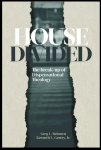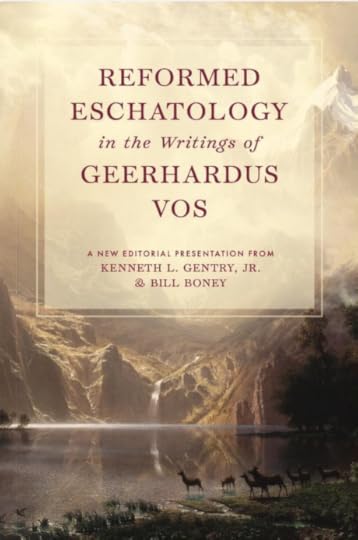INTRODUCING THE TWO WITNESSES (5)
 PMW 2024-070 by Kenneth L. Gentry, Jr.
PMW 2024-070 by Kenneth L. Gentry, Jr.
Though this is my fifth study on the identity of John’s two witnesses, I come now to my fourth point. This should be read in tandem with the preceding study.
Fourth, further confirming this approach is the two witnesses’ prophetic fire-and-blood imagery (11:5– 6; cp. Eze 21:32; 38:22; Joel 2:30), the joyful reaction to their death by “those who dwell in the Land [of Israel]” (11:7, 9–10), and the “torment” they cause their Jerusalem hearers (11:10; cf. v 8). The temple and Jerusalem will suffer fiery destruction (Mt 22:7; Ac 2:19–20). The witnesses are not simply gospel preachers, or else they would not be deemed tormentors. Rather, they are functioning as covenant-lawsuit prophets challenging the integrity of the central feature of Judaism: the temple. In Revelation the word-group for “torment” elsewhere speaks of extreme pain and agony, not annoyance or frustration. Thus, some scholars argue that “the two witnesses do not symbolize the preaching of the Gospel in general . . . They are the incarnation of the witness which the Church renders to Christ in the face of a Judaism grown obstinate in its unbelief.”
I would add to this observation that their witness promotes the word of Christ against the temple which the Jews so dearly love, and which figures prominently in Christ’s trial (Mt 26:59–61; 27:40; Mk 14:58–59), as well as in Stephen’s (Ac 6:13–14). Another observes in this regard that: “well may we suppose that Christians . . . urged the declarations of the Saviour as to the impending fate of Jerusalem.” He points out (2:227) that the two witnesses “were prophets in the church, predicting the destruction of the temple and the Jewish commonwealth.” Elsewhere we learn that: “putting the synoptic and Johannine evidence together — and the two appear to be independent — we have a strong presumption that Jesus did say something about the destruction and replacement of the temple.”
The extreme Jewish zeal for the temple is well-known and amply documented in ancient sources: 1 Macc 2:19–22; 3:12; 5:15; 14:31; Aristeas 83–87; Philo, Spec. Laws 1:13 §72–73; Embassy 29 §191, 198; Jos., Ant. 13:3:4 §77–78; J.W. 6:4:7–8 §260–67. They fiercely protect their holiest place, as we see in: Philo (Embassy 32 §232–33), Josephus (Ant. 14:16:2 §470; 17:6:2 §151–52; 18:8:2–3 §261–72; J.W. 2:9:4 §175–77; 4:3:9–10 §158–92; 6:1:7 §73–74; 6:4:5 §253), Tacitus (His. 5:9), Dio (49:22:3–5; 69:12:1–2), and 2 Macc 15:18; 18:20ff.
This is why that after Stephen’s preaching against the temple (Ac 7:48–50) and Israel (Ac 7:51–53), the Jews turn violently upon him: “Now when they heard this, they were cut to the quick [lit. “to the hearts,” tais kardiais], and they began gnashing their teeth at him. . . . They cried out with a loud voice, and covered their ears and rushed at him with one impulse. When they had driven him out of the city, they began stoning him; and the witnesses laid aside their robes at the feet of a young man named Saul” (Ac 7:54, 57–58). They consider Stephen’s preaching torment (“they were cut to the quick,” Ac 7:54), not annoying (as for example in Ac 2:13, and among the Gentiles at Ac 17:18, 32), which matches with the tormented anger of those in Jerusalem against the two witnesses (Rev. 11:10c).
House Divided: The Break-up of Dispensational Theology By Greg Bahnsen and Ken Gentry
By Greg Bahnsen and Ken Gentry
This book presents and defends Christian Reconstruction theology, particularly theonomic ethics and postmillennial eschatology. It does to by responding to dispensationalism’s social and exegetical theology.
For more educational materials: www. KennethGentry.com
Fifth, most scholars agree that John specifically models the two witnesses after Moses and Elijah (11:5–6; cp. 1Ki 17:1; Ex 7:17), who represent the law and the prophets, i.e., the old covenant (Mt 5:17; 7:12; 11:13; 31:42; 22:40; Lk 24:44; Jn 1:45; Ac 13:15; 24:14; 26:22–23; 28:13). The law and the prophets testify about Christ (Mt 26:54–56; Jn 5:39; Lk 24:25-27) and against Israel (Mt 15:7–9; Lk 16:31; Jn 5:45–47; Ac 13:27). For instance, Jesus warns Israel: “Do not think that I will accuse you before the Father; the one who accuses you is Moses, in whom you have set your hope” (Jn 5:45; cp. Jn 7:19–20). He declaims their treatment of the prophets God sends to them: “you testify against yourselves, that you are sons of those who murdered the prophets” (Mt 23:31; cp. 5:12).
Sixth, further indicating that the two prophets speak of judgment on geo-political Israel — and especially on their holy temple and capital city — is the heavenly response to their ministry under Israel’s resistance. Upon their deaths and their reception into heaven (11:11–13) we hear that the kingdom of the Lord has conquered — despite Israel’s opposition to Christ and his two prophets — and that “Christ . . . will reign forever” (11:15). This kingdom victory of Christ comes as a “reward” to “Your bond-servants the prophets” (11:18). Then as a consequence of the casting out of the earthly temple and the trampling of its host city, Jerusalem (11:2), along with the two witnesses’ prophetic denunciation of the temple, the heavenly temple opens (11:18). The message of the two witness-prophets prevails.
Seventh, in the vision’s imagery, the two prophets engage in fiery speech: fire “flows out of their mouth and devours their enemies” (11:5). This well fits the idea of judgment language: Jeremiah’s proclaiming God’s judgment on Israel makes his words a fire (Jer 5:14). The general theme of fiery judgment regarding Christ’s coming is familiar to the first Christians, both in speaking of his metaphorical coming in wrath in AD 70 and his literal coming in judgment at the end of history (e.g., Ac 2:19; 2Th 1:7; Heb 10:27; Jas 5:3, 9; 2Pe 3:7; Jude 7). In fact, such fiery-judgment language is prominent enough in early Christianity that Nero accuses Christians of causing the burning of Rome. In AD 64 he condemns them on “the charge of [being] incendiaries” and then “fastened [them] to crosses to be set on fire, that when the darkness fell they might be burned to illuminate the night” (Tac., Ann. 15:44). In the exposition of Revelation 13 I will show how the Jews urge Nero’s persecution of Christians.
[image error]For more information and to order click here.
" data-image-caption="" data-medium-file="https://postmillennialworldview.com/w..." data-large-file="https://postmillennialworldview.com/w..." tabindex="0" role="button" class="alignright size-full wp-image-209" src="https://postmillennialworldview.com/w..." alt="Navigating the Book of Revelation: Special Studies on Important Issues" />Navigating the Book of Revelation (by Ken Gentry)
Technical studies on key issues in Revelation, including the seven-sealed scroll, the cast out temple, Jewish persecution of Christianity, the Babylonian Harlot, and more.
See more study materials at: www.KennethGentry.com
Eighth, we also know from Jewish records that the early Christians do denounce the temple. We not only see Jewish complaints about this in the NT itself, but elsewhere. For instance, in t. Sanh. 13:4–5 the statement “those who have stretched out their hands against Zebul” is discussed one scholar of ancient Judaism: “It is explained in the Tosefta itself that Zebul (habitation) denotes the temple. The whole passage seems to be directed against heresy in some form, we may perhaps interpret this clause of those who, like the Christians, repudiated the claim of the temple to be the place where alone worship could be duly and perfectly offered.”
Still another notes that “persecution occurred when Christians challenged the symbols of ethnic solidarity so sharply that they placed themselves beyond the tolerance-limits of the Jewish community.” The Jews, therefore, seek capital punishment for any who speak against or defile the temple, not only in Jeremiah’s day (Jer 26:7–8, 11; Ant. 10:6:2 §89–92) but also in the first century (Ac 6:14; 21:26–30; 24:6; 25:7–8; t. Sanh. 13:5; t. Ros. Has. 17a; t. Ber. 9:13b). Thus, we should understand that the “controversy about the temple was evidently the occasion for the first major persecution of Christians (Acts 6–8).”
Thus ends the reading of my thoughts on the identity of the two witnesses. So far.
 Reformed Eschatology in the Writings of Geerhardus Vos, edited by Kenneth L. Gentry, Jr. and Bill Boney, is available for pre-orders now. https://axeheadpress.com/products/reformed-eschatology-in-the-writings-of-geerhardus-vos
Reformed Eschatology in the Writings of Geerhardus Vos, edited by Kenneth L. Gentry, Jr. and Bill Boney, is available for pre-orders now. https://axeheadpress.com/products/reformed-eschatology-in-the-writings-of-geerhardus-vos
Kenneth L. Gentry Jr.'s Blog
- Kenneth L. Gentry Jr.'s profile
- 85 followers



